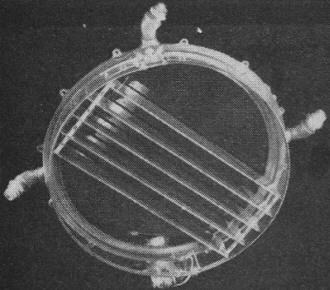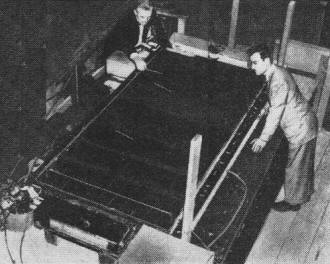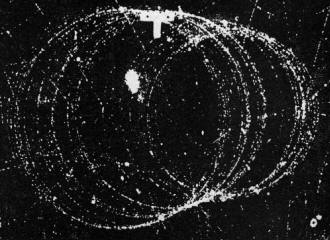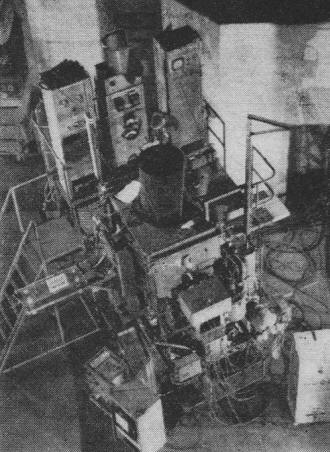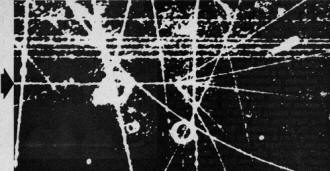After Class: Subatomic Footprints
|
|||
By now, most people involved in science and engineering have seen the iconic photos of cosmic rays and other subatomic particles leaving a signature of their presence as streaks in a cloud chamber. Invented by Scottish physicist Charles Wilson, the cloud chamber is a sealed volume containing super-saturated water vapor that can be ionized by energetic particles passing through it. The result is a tell-tale whitish line that can be straight arced, or even a spiral, depending on the nature of the particle. First developed in the early part of the 20th century, many particles predicted by researchers were detected and identified. Many unexpected particles were also encountered that gave physicists reasons to sharpen their pencils and develop new theories to explain. Similar research and discoveries occur today using super-sensitive electronic detectors instead of cloud chambers. CERN's Large Hadron Collider (LHC) is currently the world's grandest particle collider for performing atomic and subatomic particle research. After Class: Subatomic Footprints
Modern research expansion-type cloud chamber, known as the "Pantograph," has 22" diameter and is 3 1/2" high. World's largest cloud chamber, originally designed for study of cosmic ray air showers, is now in use at the "Bevatron" at U. C. Radiation Laboratory. The signature of a high-energy electron as it travels through the cloud chamber under the influence of a magnetic field. Experimental setup for use with cloud chamber. In the background, you can see the concrete shielding of the 184" cyclotron at the U. C. Radiation Laboratory. A five-billion-volt meson from the world-famous Bevatron is shown above striking a hydrogen atom in a diffusion cloud chamber, thus producing six charged particles, This is an outstanding example of the phenomenon known as multiple meson production. (The meson enters the picture from the left, as indicated by the arrow, and the collision occurs at the photo's exact center.) All Photos Courtesy of University of California Radiation Laboratory The existence of these tiny elemental bits of matter had been suspected for many years before the first "viewing" device was even conceived. As a matter of fact, they announced their presence to Henri Becquerel in 1896 by leaving their "footprints" behind them as they flashed through the emulsion of a piece of photographic film inadvertently left in a drawer near some uranium. Becquerel simply remarked in his notes that radioactive emanations from the uranium had fogged the film, not realizing that he had "invented" the first subatomic particle detector. Vapor Trails Although we cannot see these particles, we can at least see where they have been. One of the methods used to study them involves special photographic emulsions; another is the cloud chamber, invented by the English physicist C. T. R. Wilson in 1911. In the cloud chamber, the space within a hollow chamber is super-saturated with water vapor. Electrically charged particles have the ability to serve as condensation nuclei, i.e., they encourage water vapor in their immediate vicinity to change to liquid water droplets. So - as a sub-atomic particle of the charged variety strays into the chamber, it causes condensation of vapor all along its path - leaving a trail behind it much like the vapor trails that appear behind a speeding jet plane. The trail is substantially thicker than the particle itself; hence it becomes visible and may be studied. There are two basic types of cloud chambers. The Wilson cloud chamber is an expansion type in which saturated water vapor is brought to the super-saturated state by a sudden expansion of the volume of the chamber. The subatomic footprints which form in this instrument are very fleeting, lasting for about 1/30 second. Later, in 1939, Langsdorf at the University of California invented a cloud chamber in which the conditions required for track formation are maintained continuously; after many years of research, the Langsdorf chamber was perfected to the point where it could be used as a research instrument. Cosmic Rays. When no source of radiation is placed in or near the cloud chamber, almost all the tracks seen will be caused by those mysterious vagrants from outer space, the cosmic rays. Although cosmic rays in themselves are incapable of leaving tracks, their energy is so high, particularly in the upper atmosphere, that they smash into and disrupt atoms of any elements that happen to be present, releasing a shower of all kinds of charged (and uncharged) particles.
These particles include the now familiar electrons, protons, and neutrons as well as numerous other recently discovered atomic debris - -such as nine different kinds of mesons, positrons, antiprotons, lambda particles, sigma particles, and cascade particles. Most of them, with the notable exception of the neutron, two types of mesons, and the neutrino, leave characteristic vapor trails which make it possible to identify the causative agents. For instance, electrons make much fainter and thinner tracks than the heavier positive bodies. An alpha particle is a helium atom which has been stripped of its orbital electrons so that only the nucleus remains; the nucleus contains two protons and two neutrons, is quite massive, and is heavily ionizing. Alpha particles radiate from the gas radon which is always present in the air in small quantities. At first an alpha track is sharply defined, but then suddenly billows out as if it were exploding into a puff of smoke. Neutrons and other neutral particles do not leave their signatures behind them because they have no electric charge and cannot act as nuclei for condensation. There is, however, ample evidence of their very real existence. Neutrons smash into atoms and liberate other charged particles that can be identified in the cloud chamber; for instance, a fast neutron charging through the vapor may collide head-on with a hydrogen atom, tear away the latter's lone electron, and cause the proton in the hydrogen nucleus to make a track that tells the story of the atomic catastrophe. Cloud Chambers Of all the scientific devices used for research in the first half of the 20th century, the cloud chamber is probably responsible for the making of more Nobel prize winners in physics than any other. C. T. R. Wilson was awarded the Nobel prize in 1927 for the invention of the chamber itself and some of the discoveries he made with it. The positron - a particle which is the counterpart of the familiar negative electron in all respects except for the fact that it carries a positive charge - was discovered by the American, C. D. Anderson, during an investigation of cosmic rays by the use of a cloud chamber. It was also in a cloud chamber that the elusive dream of the ancient alchemists was first observed actually occurring: transmutation of one element into another. P. M. S. Blackett, Nobel prize winner in 1948, filled a cloud chamber with nitrogen and bombarded this gas with high-energy alpha particles. The alpha particles smashed into nitrogen nuclei, set up a complex series of nuclear changes from which a proton and an oxygen atom then emerged; thus, nitrogen was transmuted to oxygen. As recently as September, 1953, a new discovery of the first rank was made with a cloud chamber. At Brookhaven National Laboratory, research workers bombarded hydrogen gas in a cloud chamber with very high energy pi mesons coming from the now-famous Cosmotron accelerator. They observed the first artificially produced V-particles. Naturally occurring V-particles from cosmic rays had been studied previously with the aid of cloud chambers. The life history of a cosmic particle from space that generates its track in a cloud chamber and then comes to rest is something to capture the imagination. It may be the nucleus of a helium, iron, or nickel atom torn from its electrons millions of years ago in the very heart of an immense star thousands of times more massive than our own sun. Blown out of the star by the unimaginable energy of billions of exploding atoms ... accelerated through the vastness of interstellar space by ever-present magnetic and electric fields ... escaping collision with cosmic dust for millions of years ... it finally stumbles into our atmosphere and - in a single split second - loses all the energy stored in it since birth!
Posted May 18, 2020 "After Class" Topics
|
|||


